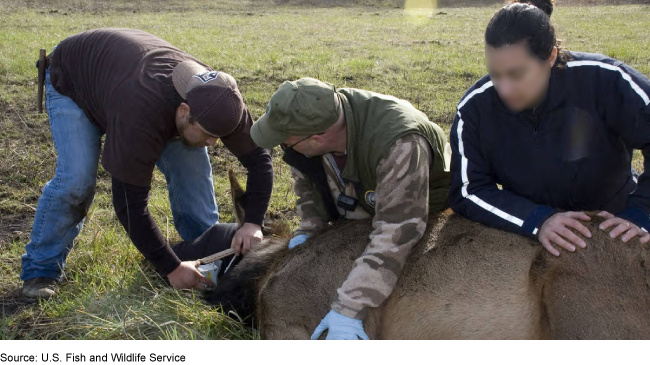Environmental Justice: Agency Actions to Implement Past Justice40 Initiative
Fast Facts
A 2021 Executive Order directed federal agencies to address disproportionate health, environmental, economic, and climate impacts on disadvantaged communities. Federal agencies were tasked with implementing the Justice40 Initiative, which aimed to ensure that 40% of benefits from certain existing grants and programs went to these communities.
By December 2024, the Environmental Protection Agency and Departments of the Interior and Agriculture had taken numerous steps to implement the initiative. But agencies faced challenges measuring benefits to specific communities. The initiative was terminated in January 2025, and the overall results of the agencies' actions prior to this are unknown.
Agency programs covered under the former Jusice40 Initiative provided grants and loans to support a range of activities

Three people attaching a collar to an Elk.
Highlights
What GAO Found
Executive Order (EO) 14008, issued in 2021 and revoked in January 2025, directed federal agencies to take action to address the disproportionately high and adverse human health, environmental, climate-related, and other cumulative impacts on “disadvantaged communities.” Specifically, the EO established the goal that 40 percent of the overall benefits of certain federal investments flow to such communities. Benefits could include, for example, improved health, lower home energy costs, or restored wetlands. The EO referred to this all-of-government effort as the Justice40 Initiative. The initiative did not itself create programs or provide funding. In January 2025, EO 14008 was revoked, thereby terminating the Justice40 Initiative.
As of December 2024, the Environmental Protection Agency (EPA), Department of the Interior, and U.S. Department of Agriculture (USDA) had taken actions to implement the Justice40 Initiative. These actions included integrating related goals and strategies into agency plans, taking steps to address barriers underserved communities face in accessing federal programs, issuing internal guidance, and modifying programs covered by the Justice40 Initiative. For example, in 2022 EPA issued guidance directing the 28 National Estuary Programs receiving funding through the Infrastructure Investment and Jobs Act to create a strategy describing how the funds would be used to increase benefits to disadvantaged communities, as well as how those benefits would be tracked.
The agencies also conducted outreach to Tribes, community groups, state and local governments, businesses, and the public to inform these efforts. For example, in 2022 USDA established an Equity Commission that identified barriers to inclusion or access to USDA programs. USDA then took steps to address those barriers, such as by publishing a guide to help underserved farmers, ranchers, and forest landowners better understand and access programs and resources available to them.
The three agencies also took preliminary steps to assess the results of their actions to implement the initiative. These steps included identifying data needed to evaluate barriers to and progress toward the Justice40 goal, and reporting on some programs’ funding to and impacts on underserved communities. For example, Interior reported that as of fiscal year 2024 approximately 44 percent of the more than 9,600 abandoned oil and gas wells plugged by state and local partners with funding from Interior’s Orphaned Wells Program were in disadvantaged communities.
With the termination of the initiative in January 2025, the overall results of agency actions remain unknown. According to GAO’s review of agency and Office of Management and Budget (OMB) materials, by December 2024 EPA, Interior, USDA, and OMB had not reported on what benefits resulted from each program, how those benefits were measured, or what the overall amount of funding or benefits was delivered to disadvantaged communities. Further, as of December 2024, neither the three agencies nor OMB had reported any assessments of agency actions to implement the initiative. The three agencies faced a variety of challenges identifying and measuring benefits across programs that operate at various geographic and time scales—benefits that may be difficult to attribute or quantify and may take years to manifest.
Why GAO Did This Study
Federal agencies were tasked with implementing the Justice40 Initiative for their programs—including those established by the Inflation Reduction Act of 2022 (IRA) and Infrastructure Investment and Jobs Act—that made investments in certain areas, such as clean transit and training and workforce development. By November 2023, 19 agencies had identified 518 programs that made qualifying investments, such as grants and loans, to Tribes, states, individuals, organizations, and other entities. According to the Executive Office of the President’s 2023 Environmental Justice Scorecard, Congress appropriated approximately $613 billion total for the programs for fiscal years 2022 through 2027, including supplemental appropriations such as the IRA.
TThe IRA included a provision for us to support oversight of the distribution and use of funds appropriated under the IRA and whether the economic, social, and environmental impacts of those funds are equitable. We were also asked, prior to the initiative’s termination, to review implementation of the Justice40 Initiative. This report provides information on the actions that three of the agencies with the most covered programs had taken, as of December 2024, to implement the initiative and related efforts, as well as steps they had taken to assess those actions. The three agencies GAO examined are EPA, Interior, and USDA. This report also provides information on how OMB had used the agencies’ data on Justice40 implementation as of December 2024, prior to the initiative’s termination in January 2025.
GAO reviewed documents from and interviewed officials and staff at EPA, Interior, USDA, and OMB to understand the actions each had taken as of December 2024 to implement and assess the Justice40 Initiative.
For more information, contact J. Alfredo Gómez at gomezj@gao.gov.
